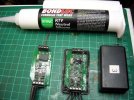GAP
G Scale Model Trains, 1:1 Sugar Cane Trains
Thinking outside the box a bit here but here goes.
I use battery R/C for my locos but I have an NCE "Powercab" that I was planning on using on my small HO layout, but as I also have an NCE "Twin" as well, i thought that I could use that on the HO (small layout 2 trains at a time would be heaps) thus leaving me with the Powercab.
My thoughts are to use the Powercab to control the points (and other lineside items may be later) on my elevated G scale layout that is outside.
Power is not a problem as I have a 240V external power point 1 metre away from the layout on the outside of the shed or I can run Low voltage from the shed and as the baseboards are fibre cement and waterproof I can put controllers underneath out of the weather.
As the powercab is rated at 2 A only I may need a booster but if I am only changing 1 set of points at a time would I really need one?
I am guessing that a decoder per point would be necessary to control, probably servos that would do the mechanical work yes?
The majority of the points are LGB manual control with some Accucraft manual control and 2 Lionel manuals. Not all points need to be servo driven just some that are in more remote parts of the layout.
These are a couple of questions that I hope someone can say yea or nay before I go to far down the DCC lineside control track.
My other option is to use a Paspberry Pi via wifi to control servos but that is another subject altogether unless someone can offer some help.
I use battery R/C for my locos but I have an NCE "Powercab" that I was planning on using on my small HO layout, but as I also have an NCE "Twin" as well, i thought that I could use that on the HO (small layout 2 trains at a time would be heaps) thus leaving me with the Powercab.
My thoughts are to use the Powercab to control the points (and other lineside items may be later) on my elevated G scale layout that is outside.
Power is not a problem as I have a 240V external power point 1 metre away from the layout on the outside of the shed or I can run Low voltage from the shed and as the baseboards are fibre cement and waterproof I can put controllers underneath out of the weather.
As the powercab is rated at 2 A only I may need a booster but if I am only changing 1 set of points at a time would I really need one?
I am guessing that a decoder per point would be necessary to control, probably servos that would do the mechanical work yes?
The majority of the points are LGB manual control with some Accucraft manual control and 2 Lionel manuals. Not all points need to be servo driven just some that are in more remote parts of the layout.
These are a couple of questions that I hope someone can say yea or nay before I go to far down the DCC lineside control track.
My other option is to use a Paspberry Pi via wifi to control servos but that is another subject altogether unless someone can offer some help.





